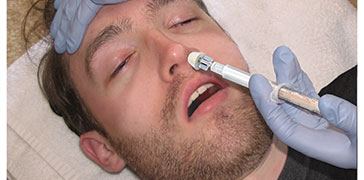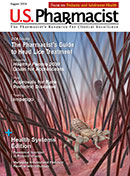US Pharm. 2022;47(6):15-16.

An Alarming Epidemic
Opioids are a class of drugs that include the illegal drug heroin, synthetic opioids such as fentanyl, and pain relievers available legally by prescription, such as oxycodone (OxyContin), hydrocodone (Vicodin), codeine, morphine, and many others. Prescription opioids are used to manage short-term and chronic pain. However, because these same medications can cause euphoria in addition to pain relief, the potential for abuse is very high. Prescription opioids can be expensive, leading to addicted persons seeking out illegal substitutes like heroin and fentanyl, which are considerably cheaper. In fact, 80% of individuals addicted to heroin first misused prescription opioid medications.
Slow, Irregular Breathing
In 2021, deaths from drug overdose increased by 28% over 2020, surpassing 100,000 deaths. The majority of these overdose fatalities were due to the synthetic opioid fentanyl. Several factors can increase the risk of overdose, including changes in tolerance from not using or using less, such as after detoxing in a program or jail; drugs such as heroin and fentanyl used together; combining opioid use with alcohol or benzodiazepines; having health issues that affect the heart, kidneys, or lungs; and surviving an overdose in the past. Opioid overdose causes a slow, irregular breathing pattern in a person who appears unconscious or unresponsive. The person’s lips or fingernails may turn blue from lack of oxygen, and the pupil of the eye becomes very small. Opioid overdose is a medical emergency, and prompt treatment is necessary.
Naloxone Autoinjector and Nasal Spray
Emergency treatment includes the administration of naloxone, a drug that quickly reverses the dangerous effects of opioid overdose. Naloxone (Evzio, Narcan) is available as an injectable, an autoinjectable, and a prepackaged nasal spray. It can be given by first responders, family, or friends to stabilize the overdose victim until medical assistance arrives. It is used to reverse the dangerous effects of slowed or stopped breathing brought on by an overdose and prevent damage to the brain or even death. Naloxone begins to work in less than 2 minutes, and its effects last for 30 to 90 minutes. In cases where the effects of the opioid outlast the naloxone, additional doses can be given until the individual arrives at the hospital.
The U.S. Surgeon General encourages people to carry naloxone nasal spray to treat overdose victims until they can receive medical attention. It is essential for friends and family of individuals with a known history of opioid abuse to have naloxone on hand in case of emergency. Anyone can purchase naloxone nasal spray directly from the pharmacy without a prescription from a doctor.
The spray is administered in one nostril while the individual is lying on his or her back. Naloxone reverses deadly opioid overdose symptoms, but it can also produce withdrawal symptoms in people who are chronic users of these pain medications and are physically dependent. Withdrawal symptoms from opioids include nausea, vomiting, yawning, abdominal cramping, goosebumps, sweating, watery eyes, fast heartbeat, body aches, and diarrhea. Although these symptoms are uncomfortable, they are usually not severe. They can be treated by a healthcare professional once the patient is stable.
Preventing Opioid Overdose
Preventing dangerous opioid overdose is critical to reducing the disability and death associated with opioid addiction. Medications are available to treat opioid dependence and are used in combination with counseling and other supportive services. Methadone, buprenorphine with or without naloxone, and naltrexone are three currently approved treatments for opioid-use disorder. They are prescribed by well-trained healthcare practitioners, typically in specialized drug-treatment facilities. Methadone is an oral medication that attaches to opioid receptors in the brain and blocks withdrawal symptoms and cravings. Buprenorphine partially blocks the same receptors to lessen the symptoms of withdrawal. Naltrexone is a monthly injection that works by blocking the euphoric effects of opioids and alcohol and helps reduce cravings.
If you or a loved one is struggling with substance abuse, call the SAMHSA National Helpline at 1-800-662-4357 for treatment and information.
The content contained in this article is for informational purposes only. The content is not intended to be a substitute for professional advice. Reliance on any information provided in this article is solely at your own risk.
To comment on this article, contact rdavidson@uspharmacist.com.






